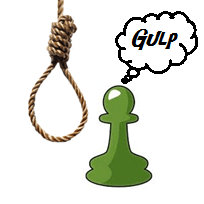
The Positional Sacrifice
The term "positional sacrifice" is construed by many players as a vague concept applied only in relation to complex positional battles between grandmasters. I exaggerate a bit, of course, but the art of sacrificing for positional compensation appears daunting and unlearnable. Few players are afraid to invest material for clear, concrete reasons (such as an attack on the king, or a combination to win the material back), but to sacrifice for nebulous strategic reasons is a horse of another color. Besides, it is tempting to assume that such positional finesse is unecessary at a non-GM level. However, my experience has taught me - time and again - that one of the steps to positional mastery is the ability to reconsider your attachment to material.
We will begin with a few definitions: for which type of compensation is a positional sacrifice made? In the interest of space, we will focus on the following sampling of potential reasons:
- Piece placement. Frequently, a pawn or even more should be sacrificed to disrupt your opponent's piece coordination, or to secure good squares for your own pieces.
- A space advantage. It is easy to underestimate the importance of maneuvering space for your pieces (and a lack of it for your opponent), but most players hate dealing with a cramped position.
- A particularly important piece trade. For instance, you might sacrifice a pawn or exchange to eliminate a strong bishop, or to transpose into a favorable endgame.
- Destruction of pawn structure. In my second article, I discussed the concept of voluntary ruination of pawn structure, but sometimes, the only way to uncover the flaws in your opponent's position is to induce a weakness in his or her pawn structure.
A significant amount (but certainly not all) positional sacrifices fall into one or more of the above categories. Before we delve deeper, however, we must recognize the fallacy inherent in the misconception that positional sacrifices are unnatural, risky ventures to be undertaken only by the crème de la crème. To the contrary, in many cases, a positional sacrifice is the natural continuation of a plan or an obvious way to satisfy the necessities of the position. I am not saying that positional sacrifices are trivial or always sound, but that you should not choose a materialistic approach simply because you do not consider yourself a positional expert.
And now, we will tackle the aforementioned list one point at a time.
1. In my opinion, piece placement is one of the thorniest sub-topics in the entire realm of positional chess. We will limit ourselves to one important point: the placement of one piece - an unassailable outpost for a knight or an uncontested diagonal for the bishop, for instance - can fundamentally alter the evaluation of the position. Tarrasch's aphorism ("One piece stands badly, the whole game stands badly") might be trite, but it contains more than a grain of truth. In the following game, GM Artur Yusupov demonstrates that you should not be afraid to give up significant material to secure a crucial square for one of your pieces.

2. Some players loathe dealing with a space advantage, considering it a liability rather than a plus.
"What exactly is the benefit of a space advantage?" they ask.
To answer this question, we must classify the space advantage as a transitional advantage: one that might not be decisive in its own right, but that can be easily converted into a myriad of other advantages. Frequently, such a trump card is well worth a small material investment.
3. In many instances, you might find that your opponent's position stays afloat solely due to the placement of one particular piece (in a way, this is the converse of Tarrasch's quip). For example, if White succeeds in trading the g7 bishop in the Sicilian Dragon, Black's position instantly crumbles in nine cases out of ten. Thus, you should never rule out a sacrifice that aims to eliminate a particularly important or troublesome piece. I analyzed the following game in my book Mastering Positional Chess, but it is so instructive that it bears repeating:
4. Ah, pawn structure yet again! If the elimination of a vital piece is a concrete achievement that can make a sacrifice easy to go for, pawn structure is a far more amorphous type of compensation. Nevertheless, one of the key abilities in a Grandmaster's toolkit is his capacity to recognize in which specific positions the pawn structure is important. The following game, a relatively unknown masterpiece by GM Kramnik, is one of my favorites:

Most, if not all, chess players have an inherent attachment to material. However, it is crucial to recognize that certain positional factors can prove far more important than a material count. In Yusupov-Narciso and Charbonneau-Huzman, White's domination so outweighed his slight material investment that Black's extra pawn or exchange was hardly visible. Time and again, the flexibility of modern positional chess is put on full display - to create a strategic masterpiece, you must often do away with the notion that material is sacred. As usual, any feedback is greatly appreciated. Ciao!
RELATED STUDY MATERIAL
- Learn more about material for position trades in IM Silman's article The Classic Bishop Sacrifice;
- Throw away material and come out ahead in Chess Mentor;
- Maintain your tactical brilliance in Tactics Trainer;
- See more counterintuitive material exchanges in GM Gregory Kaidanov's Sacrificing a Queen for Two Minor Pieces! - Part 1.






